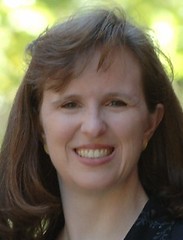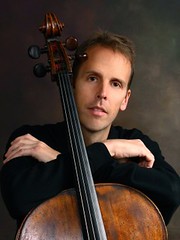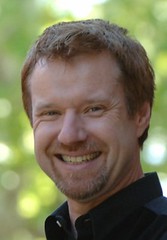
Flutist Lisa Schroeder and classical guitarist Michael Nigro present a program of Latin American music.
Lisa Schroeder and Michael Nigro join their musical talents to create Noteworthy Duo. Their vision is to reach a non-classical audience, inspire the classical listener, and to touch just one life with a "noteworthy" performance. Noteworthy’s interest in South American Music can be heard throughout their extensive flute and guitar repertoire.
This past year, the duo toured to 23 states in the U.S., playing concerts, live television programs, and radio shows. Their debut CD, entitled “Between Guitar and Flute” was released in February 2009. Lisa and Michael are both on faculty at Vanguard University of Southern California.
During the course of their concerts, in an informal manner, Michael and Lisa often include commentary, information, and anecdotes about the composers and pieces they are performing. Their striking ability to communicate with their audience makes "Noteworthy" performances seem more like an intimate gathering of friends than a recital for strangers. They have received rave reviews for their concerts across the country, “Noteworthy’s concert was a highlight of our concert season. Michael and Lisa play as if they have performed together forever--with joy, superb musicianship and impressive ensemble. From their first moments on stage through the last piece, Michael and Lisa kept the audience absorbed with their expressive playing and engaging commentary. This was a first-rate concert experience.” (Atonement Lutheran Church Boulder, CO)
PROGRAM SELECTIONS
Piazzolla
Cordero
Cardoso
Machado
Cardoso
Piazzolla
Pujol
Flutist Lisa Schroeder is a Los Angeles based performer, teacher, and clinician. As a Solo Artist with Altus Flutes, and as flutist with Noteworthy Duo, Lisa has established herself as a first-rate artist and teacher, performing in Concerts and giving Master Classes across the United States and Europe. She is the winner of the 2009 National Flute Association Convention Performers Competition, and a consecutive winner (2008, 2009) of the Professional Flute Choir Competition in which she performed principal bass flute at the Kansas City and New York City Conventions. Her expressive playing transports the audience into the music and has received praise from the flute community. Gary Schocker, a renowned flutist/composer/pianist, states “Lisa Schroeder is a dynamic performer who brings her own style to the flute.”
As a high school junior, she attended the esteemed Interlochen Center for the Arts and knew from that moment on that she was destined to be a flute performer. Lisa began her collegiate music studies at Eastern Michigan University and later relocated to Nashville, Tennessee where she received her Bachelor of Music degree in flute performance from Middle Tennessee State University. While in Nashville, Lisa gained experience in performing, teaching, and recording session work with area singer/songwriters. She held the piccolo position in the Tennessee Philharmonic and the flute position with the Music City Winds.
In 2002, Lisa performed in the John Barcellona Master Class in Kentucky, after which the internationally acclaimed flute performer/teacher invited her to study with him in Southern California. She in turn received her Master of Music degree in flute performance from California State University Long Beach. Her interest in new music inspired a thesis entitled, “Twentieth-Century Techniques in Flute Literature: Learning and Teaching Multiphonics”.
Lisa Schroeder has performed in Master Classes with Gary Schocker, Peter Lloyd, Michel Debost, Debora Harris, Angeleita Floyd, John Barcellona, Jim Walker and Sir James Galway. Her primary teachers have included Dr. John Barcellona, Dr. Yvonne Chavez-Hansbrough, Dr. Deanna Hahn-Little, Dr. Julie Stone, and Ann Richards of the Nashville Symphony.
Mrs. Schroeder currently teaches flute at Vanguard University of Southern California, Cerritos College, Golden West College, and directs the Rolling Hills Flute Choir. Her passion for teaching has brought about her annual “Flute Loops” camp held in Palos Verdes, CA.
Michael Anthony Nigro showed an interest in the guitar at an early age and began playing by the age of 12. After several years of lessons with local teachers and self-study, he attended the prestigious Indiana University School of Music where he graduated with his Bachelor of Music Degree in 2000 under the direction of Ernesto Bitetti.
After moving back to his native Southern California, he attended California State University, Fullerton and earned a Master of Music degree under the tutelage of David Grimes.
Michael Nigro’s debut recording, “Homage to Piazzolla; Argentine Dances, Songs, and Rhythms,” is released on the label, Music & Arts. The American Record Guide stated, “Nigro has a big sound, a smooth tone, and sure-footed interpretive instincts.” His latest CD, “Guitar Sudamericana,” is released on the Austrian label, Balcon Records and features guitar works by Heitor Villa-Lobos, Antonio Lauro, Adolfo Luna, Jose Luis Merlin, and many others.
As a performer and teacher, Michael has played concerts and Master Classes at many esteemed colleges which include Bates College in Lewiston, Maine, Glendale Community College in Glendale, Arizona, Marist College in Poughkeepsie, New York, Marlyhurst College in Portland, Oregon, William Jessup University in Rocklin, California and many others.
Michael is an active member of the guitar community; he is co-founder of the Long Beach Classical Guitar Society, independent reviewer of new music publications for Soundboard Magazine, and sought after teacher and performer.
In January 2006, Michael joined the faculty at Vanguard University of Southern California where he teaches private guitar, class guitar, and guitar ensemble. Mr. Nigro is endorsed by for Savarez Strings exclusively.
Ástor Piazzolla (1921-1992) pretty much single-handedly reinvented the Argentine national dance, the tango, transforming it into a new style aptly called nuevo tango ("new tango"). Born in Argentina, Piazzolla spent most of his childhood in New York, and there he gained exposure to and a fondness for jazz and classical music. But through his father's influence he also gained proficiency on the bandoneón, a type of concertina that is a staple of Argentine tango ensembles, and when he returned to Argentina in 1937 he played with some of the leading bands in Buenos Aires. He also began the serious study of composition with noted composer Alberto Ginastera, and for an early symphony he won a grant in 1953 to study in Paris with legendary composition teacher Nadia Boulanger. Boulanger convinced him to toss out his early works that that sounded derivative of other composers, and concentrate on his own unique style that arose from Argentine dance music. When he returned to Argentina in 1955, his "new tango," which infused traditional elements with characteristics of jazz and incorporated contrapuntal techniques and formal elements adapted from his classical studies, was met with resistance in his homeland, but Europeans and North Americans were captivated by it and his international career blossomed. It is estimated that he composed over a staggering 3,000 pieces, and he recorded about 500 of them himself! The original four movements of flute and guitar suite L'histoire du tango (History of the Tango) trace the development of the tango, beginning with Bordel 1900, inspired by its early roots at the fringes of society, followed by Café 1930, that demonstrates the somewhat more polite style that became the most popular dance throughout the whole of Argentina. Piazzolla’s six Études tanguistiques ("Tango Studies") for solo flute were written in 1987, and have also become popular in a transcription for solo violin. Étude No. 3 is a florid virtuoso piece with quickly shifting textures that sometimes give the impression that more than one flute is playing!
Although composer and guitarist Ernesto Cordero (b. 1946) was born in New York, he grew up in Puerto Rico and joined the guitar and composition faculty at the University of Puerto Rico in 1971. His works often draw inspiration from the folk music of the Caribbean, and particularly from the Afro-Hispanic music of Puerto Rico. Like many guitarists he favors his own instrument when composing, and his catalog includes six concertos (three for guitar, one for violin/mandolin, one for flute-piccolo and one for the Puerto Rican cuatro), a variety of chamber works with guitar, as well as solos pieces. The recipient of several important composition awards, his music is performed and recorded worldwide, and he is in demand as a participant in international competitions and festivals for the guitar.
Argentine composer and musicologist Jorge Cardoso (b. 1949) is internationally renowned as a guitarist and lecturer, and in his spare time he's also a medical doctor! Most of his 350+ solo, chamber and orchestral works naturally feature his own instrument, and, in addition to receiving frequent worldwide performances, many have been recorded by over 100 different guitarists. Considered a leading authority on the music of Latin America, his original compositions are infused with characteristics derived from South America's musical heritage.
CLICK HERE to watch the composer perform Milonga on YouTube.
Celso Machado (b. 1953) has been living in Vancouver since 1989, but he is originally from Brazil. The decision to become a professional musician was an easy one: his father was a guitarist and band leader in Brazil, and five of his six brothers are also musicians. Celso himself began playing in street bands when he was 7 years old, and although he performs internationally as a guitar virtuoso, he plays percussion and other instruments as well. His recordings are critically acclaimed, and for the film In the Company of Fear he won a Canadian Leo Award for Best Musical Score for Documentary in 2000. The music and rhythms of his homeland continue to permeate his music, but he also includes other folk traditions among his influences, and he has collaborated extensively with Chinese pipa (lute) player Qiu Xia He. The chôro form is the oldest and perhaps most important musical form associated with Brazil, and from it developed the popular samba of the 1960s. Even though the term "chôro" originally referred to "a cry of lament," chôros are often happy, lively virtuoso pieces, and they have long been associated with flute and guitar.
In 1989 the Argentine Composers' Union named Máximo Diego Pujol (b. 1957) as their country's "Best Composer of Classical Music," and his harmonically rich works have won composition awards in Colombia, France and Martinique. Pujol is influenced by his homeland's most famous composer of tangos, Ástor Piazzolla, and in his Suite Buenos Aires, Pujol specifies more immediate inspiration. With this work the composer offers a personal tour of his hometown, beginning in the respective working-class and Italian neighborhoods of Pompeya and Palermo, then through the fashionable San Telmo area with its cafés and antique shops, and ending in the bustling Microcentro, the city's business and commercial hub.
CLICK HERE to watch a performance of San Telmo on YouTube.








